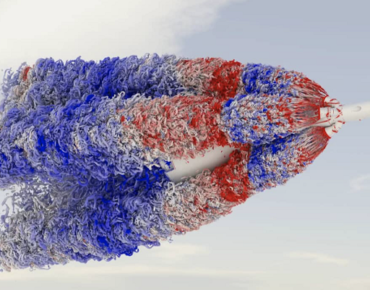NASA Simulator Shapes Orion Spacecraft Design

NASA is using flow simulations running on its Pleiades supercomputer to help design the agency’s next manned spacecraft, Orion.
Crew safety is paramount, so NASA engineers are using the HPC cluster to simulate and visualize Orion’s launch abort system that would carry the spacecraft away from its booster during a launch pad or ascent abort. The flow simulations also would help reduce design costs while reducing the weight of abort system—weight being the key criteria in all spacecraft and booster designs.
The Orion project marks one of the first times the space agency has used large-scale flow simulations in a full-blown spacecraft analysis and design, said Francois Cadieux, a research scientist with NASA’s Advanced Supercomputing Division. Simulation fidelity has reached “a point where it can provide accurate predictions within a short enough turnaround time to guide Orion’s design,” Cadieux added.
Among the abort system simulations were a variety of computational fluid dynamics runs using NASA’s in-house Launch Ascent and Vehicle Dynamics software. Visualizations were used to help researchers identify different vortices, a frequent source of noise and vibration on spacecraft as they go supersonic.
The abort simulations tracked vortices and pressures along the spacecraft. Those simulations helped engineers understand how vibration levels fluctuat along the spacecraft surfaces, and how the location of short-duration and vibration loads change and diminish as vehicle velocity and altitude increase.
The Orion abort simulation consumed about 2.5 million hours of processing time on the Pleiades supercomputer over the past year, generating about 700 terabytes of data. Pleiades is operated by NASA’s Ames Research Center in California.
Based on those data, visualization experts created high-resolution images and videos depicting simulation details about the flow dynamics of launch abort rocket plumes. “From these visualizations, we were able to identify areas of high vibrational loads on the vehicle, and their sources,” said Cadieux. “What we learned is that noise coming from the turbulence of the plume is substantially higher than any noise generated from its interaction with attached shockwaves.”
Added Cetin Kiris, chief of NASA Ames’ Computational Aerosciences Branch: “Pleiades is absolutely essential for running these large-scale simulations, storing the data and post-processing the data to deliver meaningful data products.”
The next step will be applying data gathered in the flow simulations in a series of Orion ground, crew mockup and flight tests. The first Orion flight with a crew aboard is currently scheduled for launch by 2023. Orion was to be lofted into orbit by NASA’s delayed Space Launch System. Hence, agency officials said this week they are considering commercial heavy-lift boosters in order to stay on schedule.
Related
George Leopold has written about science and technology for more than 30 years, focusing on electronics and aerospace technology. He previously served as executive editor of Electronic Engineering Times. Leopold is the author of "Calculated Risk: The Supersonic Life and Times of Gus Grissom" (Purdue University Press, 2016).











